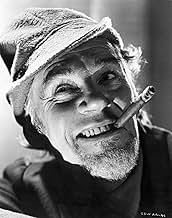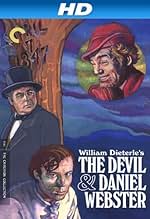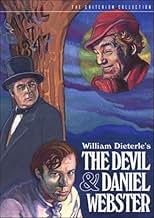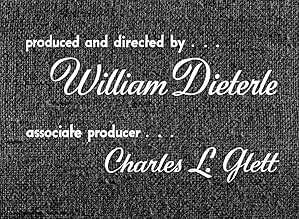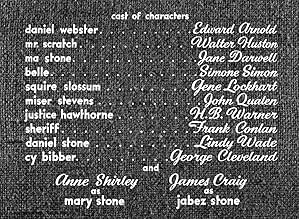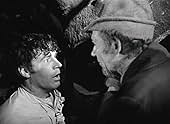Un fermier du New Hampshire du XIXe siècle conclut un pacte avec Satan pour assurer sa réussite économique, puis fait appel au célèbre orateur Daniel Webster pour l'extraire de son contrat.Un fermier du New Hampshire du XIXe siècle conclut un pacte avec Satan pour assurer sa réussite économique, puis fait appel au célèbre orateur Daniel Webster pour l'extraire de son contrat.Un fermier du New Hampshire du XIXe siècle conclut un pacte avec Satan pour assurer sa réussite économique, puis fait appel au célèbre orateur Daniel Webster pour l'extraire de son contrat.
- Réalisation
- Scénario
- Casting principal
- Récompensé par 1 Oscar
- 2 victoires et 1 nomination au total
- Spectator
- (non crédité)
- Hank
- (non crédité)
- Poker Player
- (non crédité)
- Woman
- (non crédité)
- Martin Van Buren Aldrich
- (non crédité)
Avis à la une
A cautionary tale of greed and power, the narrative centers around the character of Jabez Stone (played by James Craig), a down-on-his-luck farmer who is barely able to support his family in 1840s New Hampshire. When the nefarious Mr. Scratch (Walter Houston) appears during a moment of weakness, Jabez agrees to sell his soul in exchange for seven years of good luck. Much to the dismay of his wife (Ann Shirley), mother (Jane Darwell), and beloved politician Daniel Webster (Edward Arnold), Jabez slips into a downward spiral as a result of his newfound wealth and power. When his seven years are up, Jabez learns the error of his ways and wants to make amends. To escape his contract with the devil, Jabez puts his fate in the hands of the almost mythic Daniel Webster, who represents him in a climactic barn room trial against Mr. Scratch and a jury of the damned.
The execution of this story is remarkable, from the elegant direction and incredible performances to the innovative camera work and stylish mise-en-scene. Dieterle infuses the film with stark contrast lighting and masterful compositions rich in detail and multiple layers of action. When Mr. Scratch appears in Jabez's barn, he is heavily backlit and accompanied by ethereal sounds. His accomplice, the creepy Belle, is similarly introduced beside a fireplace. To portray the film's more ghostly effects, including Belle's dance to the death with Miser Stevens and the barn room trial, Dieterle relies on multiple exposure and diffused lighting. These visual effects and others, such as items bursting into flame, were ahead of their time - as were the lighting schemes. Influenced as Citizen Kane was by German expressionist films, The Devil and Daniel Webster features bold, suggestive lighting where shadows alone often represent a character. Dieterle succeeds in creating a visual distinction between the real world and the netherworld by frequently bathing Scratch and Belle in soft light or diffusion and removing all natural sounds from the soundtrack when they appear. Belle's dance of death and Scratch's fiddle playing at Jabez's party are accompanied by severe under lighting, insinuating the hellish forces at work in both scenes. Every shot in the film, even in the mundane world, seems painstakingly planned and executed, with decisive lighting and many intricate camera movements, rare for this era of film-making.
The most remarkable performance in the film is Walter Houston's Mr. Scratch.
Houston, an Oscar-winner for his role in Treasure of the Sierra Madre, exudes unbridled glee with every devilish grin. His devil is a gentleman-like puppet master, a smooth talker, and very persuasive. He never flaunts his evil powers. He doesn't have to. His appeal is understandable because he can offer what everyone in the movie wants - wealth and power. It's easy for the Devil to sell his wares to struggling farmers, so he's confident and playful in his duties. Houston throws away one-liner after one-liner, owning the screen and stealing the show. At one point, he offers to help Daniel Webster win the presidential election. Webster replies, "I'd rather see you on the side of the opposition." As Webster walks away, Houston replies, "Oh, I'll be there, too," and sticks a cigar in his mouth.
To combat the devil, Dieterle cast Edward Arnold (who was actually recast when the original actor was injured during filming). Arnold had a tough job in the film, making believable not only Daniel Webster's mythic stature, but also his flowery rhetoric about patriotism and the goodness in all men. He admirably succeeds in not only persuading the jury of the damned, but in holding his own against Walter Houston in their many scenes together.
Everyone else in the cast is also excellent. James Craig pulls off Jabez Stone's fall from grace, and Ann Shirley is a believable virtuous wife. Jane Darwell, fresh off her Oscar-winning stint as Ma Joad in The Grapes of Wrath, seems to be playing the same character in The Devil and Daniel Webster, but it serves the movie well. The most notable supporting player is Simone Simon, whose mesmerizing Belle haunts every frame in which she appears. It's easy to see why Jabez would fall under her spell, because we, as an audience, do as well.
The icing on the Devil's cake is Bernard Herrmann's Oscar-winning score, a dynamic one that works on many levels. Herrmann incorporates several traditional folk songs into his original music, including "Devil's Dream", "Springfield Mountain", and "Miss McLeod's Reel". For Mr. Scratch and Belle, Herrmann manipulated the sound of telephone wires "singing" in the wind to create an eerie, atonal sound for the netherworld. The film also provided Herrmann a wealth of other opportunities, including a square dance and two lullabies.
A good story makes a movie worth watching once. Exquisite aesthetics makes it worth watching many times. The Devil and Daniel Webster stands the test of time as an endearing narrative with lessons we have still to learn. It's masterful direction and style, fluid editing, and charming performances make it an accessible and entertaining film for any audience. Now restored and widely available, it is sure to join the ranks of those other great classics from the late '30s and early '40s - a scintillating example of good storytelling and fine craftsmanship.
- Scott Schirmer
The Criterion DVD helped me appreciate the underrated black-and-white cinematography in this movie. It simply looks super, and even the special-effects are still pretty darned good considering the year this was made.
Character-wise, as so often is the case, the bad-guys are the most interesting in the movie. The best was Walter Huston playing "Scratch" (the Devil) and Simone Simon playing a female helper of his. Simon has the allure in this story to drive leading character "Jabez Stone" away from his sweet wife "Mary" (Anne Shirley).
Depressed and whining over his financial state of affairs and general lot in life, "Jabez" is ripe pickings for the wily "Scratch" and his cohort. The Devil makes Stone sign away his soul for money, prosperity, power, etc. Jabez gets carried away with his greed and winds up learning some valuable lessons.
Meanwhile, Edward Arnold plays "Daniel Webster," a folk hero during this time period, a man revered by all in New England. He winds up defending Jabez in a court-like scene i the end to see if he can win back the man's soul. Arnold is captivating in his role as Webster and gives an old-fashioned patriotic message at the end which would make today's Hollywood filmmakers sick.
Craig, who gets 12th billing in this film - go figure - has the most lines in the movie! How can be ignored, not only on the DVD and VHS boxes but on the bottom of the credits on this IMDb cast page? Craig overacts in his role and, thus, becomes a little annoying at times. Shirley might have been the most attractive I've ever seen here, mainly because of her strong, Christian character and down-home plain beauty that shines through in this character, Jabez's faithful wife "Mary." (She also gets slighted in the billing.)
Overall, this is a different story than anything you've seen. It's interesting, nicely directed by William Dieterle and photographed by Joseph August. Sadly, the latter died later in this decade with a heart attack. His last picture was another visual wonder: "Portrait Of Jennie."
**** stars outta ****, do see it.
One word - "fantasy". It's my favorite movie category, and this is the best one that I've ever seen. The 1940s was the decade in which horror melodramas and fantasies really began to ramp up, and this movie helped to set the standard. Stephen Vincent Benet's story is a bit changed, but not enough to diminish this American Gothic tale.
Aside from being superior entertainment, the movie simply has no weaknesses. Where to start? The casting and acting are extraordinary. Though both are most often remembered for other movies, Edward Arnold and Walter Huston turn in their best performances here. Simone Simon (known today for the "Cat People" movies) is exceptional as Belle. Anne Shirley, James Craig, and the stellar supporting cast are also great.
This is Bernard Herrmann's best film score. William Dieterle's direction is quirky and involving, propelling the film along at a fast clip. Admittably, the characters are caricatures, but Dieterle helps us to feel their trials and tribulations. The movie also features brilliant cinematography, exceptional production values, and truly superior editing (this was an early job for director Robert Wise). The scenes are quite stagey, but never disjointed - the logic of the story is unmistakable and riveting.
Huston is the ultimate "Mr. Scratch". I've seen this show many times, and it's a 10/10.
This classic fantasy based upon the legend of Faust is adapted from the story by Stephen Vincent Benet. The movie is very persuasively made , usually rise to a crescendo of emotion.Entertaining fantasy is visually striking with Walter Huston in a rare and successful comic role as sympathetic Devil. Film contains marvelous performances by main cast and secondaries actors such as Gene Lockhart, John Qualen,HB Warner,Jane Darnwell Simone Simon as a witch ad Jeff Corey appears uncredited.This cult fantasy drama is a sometimes uneven, but throughly funny and amusing recounting of the Faustian tale.
This delicate fantasy about a farmer who gradually realizes that has been deceived by the Devil has very evocative black-and white cinematography by Joseph August, Dieterle's usual and he photographed 'Portrait of Jennie'.The film won Oscars 1941 for original dramatic score by Bernard Herrmann. The motion picture is well directed by William Dieterle as a classic example of drama/comedy/fantasy of the 40s. Dieterle is a German director who was in Hollywood by 1930s and directing dramas(Scarlet down,Fog over Frisco,Fashions), costumer(Hunchback of Notre Dame,Kismet,Omar Khayyan) and biopics experts(Life of Emile Zola,Dr Ehrlich, Juarez, Madame Curie,Reuter) that were a revelation at the box-office.
Le saviez-vous
- AnecdotesWilliam Dieterle had a habit of directing with white gloves on. Robert Wise said that everyone thought it was because he had a germ or dirt phobia. During shooting of one scene, Dieterle noticed there wasn't enough mud on a carriage wheel. He pulled off his gloves, grabbed some mud, rubbed it onto the wheel, then wiped his hands on his pants and put the gloves back on to continue directing.
- GaffesCharacters in this film set in pre-Civil War America routinely use the phrase "loan shark" despite the fact that it came into the English language between 1900 and 1905.
- Citations
Mr. Scratch: You shall have your trial, Mr. Webster. But I'm sure you'll agree, this is hardly the case for an ordinary jury.
Daniel Webster: Let it be the quick or the dead, so long as it is an American judge and an American jury!
Mr. Scratch: 'The quick or the dead!' You have said it.
[he stomps on the barn floor; a door opens]
Mr. Scratch: You must pardon the leathery toughness of one or two.
Jabez Stone: [afraid] Mr. Webster!
[a line of ghosts begin entering from the trapdoor]
Mr. Scratch: Captain Kidd - he killed men for gold. Simon Girty, the renegade - he burned men for gold. Governor Dale - he broke men on the wheel. Asa, the Black Monk - he choked them to death. Floyd Ireson and Stede Bonnet, the fiendish butchers. Walter Butler, King of the Massacre. Big and Little Harp, robbers and murderers. Teach, the Cutthroat. Morton, the vicious lawyer... and General Benedict Arnold. You remember him, no doubt.
Daniel Webster: A jury of the damned...
Mr. Scratch: [laughs] Dastards, liars, traitors, knaves. Your suggestion, Mr. Webster - 'the quick or the dead.'
Daniel Webster: This is outrageous, I asked for a fair trial...
Mr. Scratch: Americans, all.
- Crédits fousFor some prints released under the title "The Devil and Daniel Webster", the opening credits start with the phrase "in front of the camera..." followed by a list of names only of the primary cast (no character names) and then the phrase "in back of the camera..." followed by a list of names only of the primary production crew, without their job roles, ending with the phase "all collaborated on the picture...." Then the title card is shown, with a story credit to Stephen Vincent Benet, and the note "this picture was originally shown with the title 'all that money can buy'." The title card is all in lower case. Finally, the opening prologue is shown as noted in another crazy credit item.
- Versions alternativesOver the years, this film was re-released more than once, partly because of its poor box office, and gradually cut down to 85 minutes. It remained in this form for many years, until it was recently restored to its full length. When this was done in the 1990s, it was unfortunately all too easy to tell which sections are restored... all the footage from the 85 minute version was in absolutely pristine, mint condition, while the long-lost, formerly missing footage has less than perfect sound and picture quality. However, the quality has been considerably improved on the DVD and on recent TV showings.
- Bandes originalesCome, Ye Thankful People, Come
(uncredited)
Music by George J. Elvey
Lyrics by Henry Alford
Meilleurs choix
- How long is The Devil and Daniel Webster?Alimenté par Alexa
Détails
- Date de sortie
- Pays d’origine
- Langue
- Aussi connu sous le nom de
- The Devil and Daniel Webster
- Lieux de tournage
- Société de production
- Voir plus de crédits d'entreprise sur IMDbPro
- Durée1 heure 47 minutes
- Couleur
- Rapport de forme
- 1.37 : 1
Contribuer à cette page



